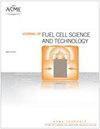集成到混合系统的SOFC堆栈模型:控制变量的堆栈响应
引用次数: 5
摘要
由于固体氧化物燃料电池(sofc)内部物理过程的紧密耦合,这些设备的有效控制在很大程度上取决于被控变量和被控变量的适当配对。本研究研究了用于混合SOFC-燃气轮机(GT)系统的SOFC堆的不受控动态行为。建立了基于电荷、物质质量、能量和动量平衡的燃料电池数值模型,并使用等效电路将燃料电池的不可逆性结合起来。然后在电化学、质量和热时间尺度上验证了该模型。模拟了不同时间尺度下正极-电解质-负极(PEN)平均温度、燃料利用率和SOFC功率对进口燃油流量、电流密度和进口空气流量阶跃变化的开环响应。结果表明,控制电流密度是改变SOFC功率最快、最有效的方法。同时,对燃油流量进行控制是改变燃油利用率的最有效方法。在未来的工作中,建议在完整的SOFC-GT系统模型的背景下进一步分析和比较这些控制策略。本文章由计算机程序翻译,如有差异,请以英文原文为准。
SOFC Stack Model for Integration Into a Hybrid System: Stack Response to Control Variables
Due to the tight coupling of physical processes inside solid oxide fuel cells (SOFCs), efficient control of these devices depends largely on the proper pairing of controlled and manipulated variables. The present study investigates the uncontrolled, dynamic behavior of an SOFC stack that is intended for use in a hybrid SOFC-gas turbine (GT) system. A numerical fuel cell model is developed based on charge, species mass, energy, and momentum balances, and an equivalent circuit is used to combine the fuel cell's irreversibilities. The model is then verified on electrochemical, mass, and thermal timescales. The open-loop response of the average positive electrode-electrolyte-negative electrode (PEN) temperature, fuel utilization, and SOFC power to step changes in the inlet fuel flow rate, current density, and inlet air flow rate is simulated on different timescales. Results indicate that manipulating the current density is the quickest and most efficient way to change the SOFC power. Meanwhile, manipulating the fuel flow is found to be the most efficient way to change the fuel utilization. In future work, it is recommended that such control strategies be further analyzed and compared in the context of a complete SOFC-GT system model.
求助全文
通过发布文献求助,成功后即可免费获取论文全文。
去求助
来源期刊
自引率
0.00%
发文量
0
审稿时长
6-12 weeks
期刊介绍:
The Journal of Fuel Cell Science and Technology publishes peer-reviewed archival scholarly articles, Research Papers, Technical Briefs, and feature articles on all aspects of the science, engineering, and manufacturing of fuel cells of all types. Specific areas of importance include, but are not limited to: development of constituent materials, joining, bonding, connecting, interface/interphase regions, and seals, cell design, processing and manufacturing, multi-scale modeling, combined and coupled behavior, aging, durability and damage tolerance, reliability, availability, stack design, processing and manufacturing, system design and manufacturing, power electronics, optimization and control, fuel cell applications, and fuels and infrastructure.

 求助内容:
求助内容: 应助结果提醒方式:
应助结果提醒方式:


